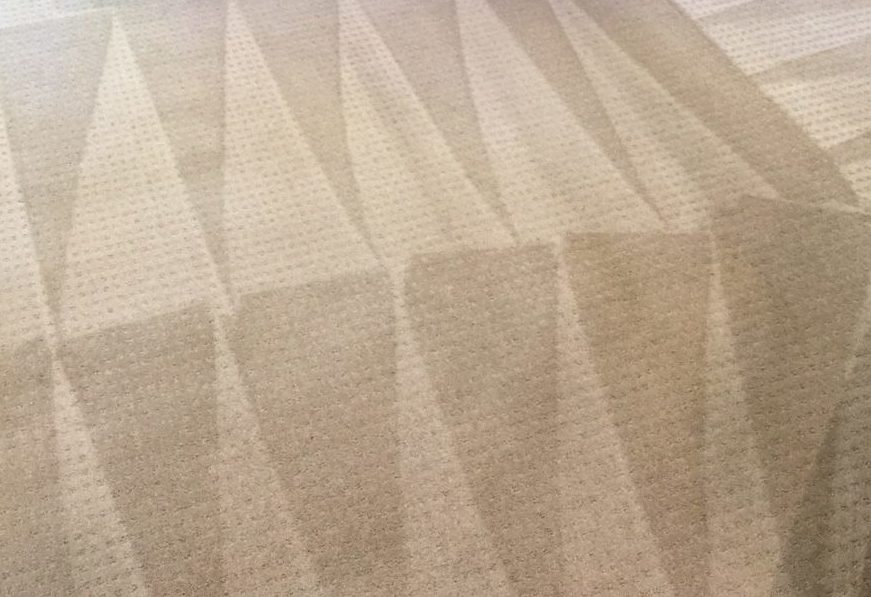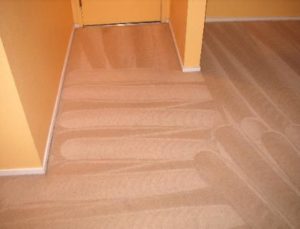
Pile distortion is a phenomenon that occurs when certain sections of pile go against the natural “grain” of the carpet. Photo: JC Carpet & Upholstery Cleaning ©2019
Have you noticed areas of your carpet that appear lighter or darker than the rest? At first glance, you might think it’s staining or fading, but what you’re more likely seeing is pile distortion—a phenomenon that occurs when certain sections of pile go against the natural “grain” of the carpet. In this article, we’ll go over some different types of carpet pile distortion and what you can do to minimize their effects.
Types of carpet pile distortion:
Shading is the general lightening/darkening effect that’s seen when the carpet fibers in certain areas lay in an opposing direction to the rest of the pile. Shading is considered a normal occurrence with cut pile carpets and is most noticeable following vacuuming, carpet cleaning or foot traffic.
Pooling (aka watermarking) is a type of shading that occurs in random, often round areas and creates an effect wherein the carpet appears wet. Despite extensive research on the part of carpet manufacturers, the exact cause of carpet pooling isn’t fully understood. What’s particularly baffling is that even after a carpet has been replaced, pooling often occurs in the same areas of the new carpet.
Pile reversal (aka side match) is a type of shading that occurs when two pieces of carpet are seamed together without regard to the pile’s natural direction. As a result, the pile on each of the joined segments may go in different directions, resulting in a large-scale shading effect that’s most conspicuous at the seam.
Roll crush occurs when a carpet is rolled up for a long period of time (as is the case for most carpets while they’re being shipped and stored). The weight of the carpet roll causes a section of the pile yard to become flattened (“crushed”), which is manifested later as a conspicuous band across the width of the carpet.

Carpet shading tends to be most noticeable after vacuuming and professional cleaning. Photo: Maximum Carpet Cleaning ©2019
Who’s to blame?
Homeowners sometimes assume pile distortion is the result of a manufacturer defect or an incompetent carpet cleaning service. The reality is that shading and pooling are considered natural occurrences with carpet and not defects. Only pile reversal and roll crush have specified causes, and neither have to do with manufacturing or carpet cleaning.
What can you do about carpet pile distortion?
Now that you know the different types of carpet pile distortion, you probably want to know what you can do to prevent or remedy it. Here are some tips:
Choose a carpet style that’s less susceptible to pile distortion. Shading and similar conditions occur most frequently on dense, cut pile carpet styles such as Saxony. To minimize shading, choose a carpet style like looped Berber or frieze.
Choose a lighter color. Shading and pooling tend to be less noticeable on lighter-colored carpets. Another good option is a dual-toned carpet that blends lighter and darker fibers to reduce shade variance.
Treat roll crush. While roll crush often self-corrects over time, a quicker solution is to correct it using a steam or hot water treatment. In acute cases, it may take a few treatments to fully bring crushed carpet fibers back to life.
Hire a high-quality installer. Since pile reversal is typically caused by poor installation, hiring an experienced, meticulous carpet installer can reduce the chances of it occurring.
Let it go. Outside of those caused by installation error, most forms of pile distortion are considered normal. With this in mind, the easiest solution may be for you to simply come to terms with this characteristic of your carpet.
Find a Diamond Certified carpet showroom in your area.
